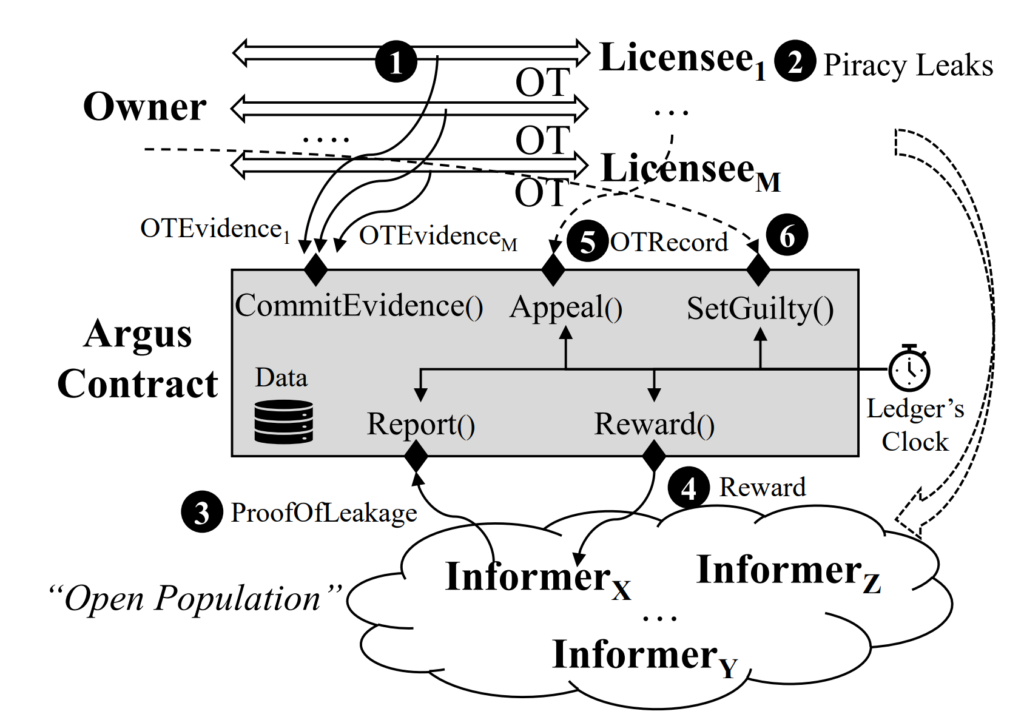Microsoft Researchers Propose a Decentralized System for Anti-Piracy Incentivization Campaigns
Intellectual property is one of the most valuable assets for present-day companies, especially in the software, movie, gaming, and digital publishing industries. Anti-piracy is a long-lasting and heavily invested effort because piracy impacts the fundamental business models of these industries. Many organizations have launched anti-piracy incentive campaigns to tackle the issue. However, these campaigns are often failing to achieve good results due to a lack of transparency.
To address the challenge, Microsoft Research Asia’s Trustworthy System Research Group has proposed an anti-piracy system named Argus, which can improve the trust foundation for a multi-party anti-piracy campaign through blockchain technology and provide improved transparency, security, and efficiency.
This technology is currently in the research stage, and the associated paper will be published at the International Symposium on Reliable Distributed Systems (SRDS) in September this year. Authors of the paper include Microsoft Research Asia researchers Xian Zhang, Zhongxin Guo, Yang Chen, Shuo Chen, Qiufeng Yin, and Mao Yang. Part of the work was completed by former engineer Xiaobing Guo and former interns Zixuan Zeng and Wenyan Liu while they worked for Microsoft Research Asia.
Motivation: The existing anti-piracy reward system is opaque and inefficient
The unauthorized use and propagation of copyrighted data undermine the legitimate rights and interests of copyright owners. Many countries have stipulated penalties for copyright infringements. For example, according to Title 17 of the United States Code, if the number or the profit of pirated copies spread exceeds a certain limit within 180 days, the copyright infringer will be fined or even detained.
Business alliances have launched anti-piracy reward programs, in which they incentivize the public to report piracy. For example, the BSA Alliance (with members including Microsoft, Intel, Adobe, etc.) announced that it would offer a reward of $1 million for the finalized and verified report of piracy. However, the process of verification and rewarding in these types of systems has been opaque, resulting in low participation of informers.
Argus System: smart contract + incentive mechanism + cryptography to build transparent and efficient anti-piracy rewards
To improve the transparency of anti-piracy rewards, researchers and interns from Microsoft Research Asia proposed and implemented a decentralized system named Argus. Compared with existing blockchain-based solutions for copyright protection, the Argus system not only tries to solve the problems of copyright registration and data transfer tracking, but more importantly, it builds a set of transparent incentives using smart contracts and a series of cryptographic technologies that can assert the existence of an infringement incident and assess its severity. The paper, “Argus: A Fully Transparent Incentive System for Anti-Piracy Campaigns” (paper link: https://www.microsoft.com/en-us/research/uploads/prod/2021/08/Argus_SRDS_Camera.pdf), will be published in the International Symposium on Reliable Distributed Systems (SRDS) in September.
As shown in Figure 1, there are three roles in the Argus system: copyright owner (owner), data user (licensee), and piracy reporter (informer). The researchers designed various protocols for the interaction between these three roles and the smart contract (the Argus contract):
(1) The owner responds to licensee’s data request through a special cryptographic protocol, which leaves a record on the smart contract.
(2) After the licensee leaks the data, the informer will report to the smart contract following protocols, and the smart contract will reward the informer after verification.
(3) Once a licensee is reported, the licensee can appeal to the smart contract within a predetermined period. If he/she does not appeal or if the appeal fails, the licensee will be identified as an infringer by the smart contract (with potential further conviction).
(4) The Argus system allows multiple informers to report on data leaked by the same licensee, making it possible to formulate an estimate of the number of pirated copies disseminated.

Figure 1. The workflow of the Argus system
The Argus system has three technical objectives: transparency, security, and efficiency. The transparency of the Argus system comes not only from the use of smart contracts, but also from the fact that all protocols in the Argus system are open, deterministic, and transparent. People of all roles—owners, licensees, and informers—can follow the protocols according to the states of the smart contract and protect their rights.
The security of the Argus system comes from its cryptographic protocols. The system aims to protect the interest of all honest participants, such as providing an accurate assessment of pirated copies to the owner; ensuring that licensees are not falsely accused, and guaranteeing that informers obtain maximum rewards. In order to achieve these goals, Argus uses Secure Watermarking to trace the source of leakage (i.e., the infringer); Oblivious Transfer to prevent owners from making false accusations against licensees; the Multi-period Commitment Scheme to prevent informers from launching replay attacks; and the Sybil-proof Incentive Mechanism to prevent informers from launching Sybil attacks.
In addition to its design-level innovations, the system consists of several implementation-level optimizations. For example, the Merkle tree is used to compress the data on the chain, and only the root node of the tree is committed to the blockchain. Private Information Retrieval is adopted to reduce the bandwidth consumption of licensees to obtain data.
Moreover, the researchers implemented optimizations for the smart contracts and the watermarking technology. They simulated the consensus nodes of the Ethereum public chain and various participants with machines on Microsoft Azure. The cost and the performance of the system are tested with various data types including images, audios, and executable binaries. Results show that the throughput of processing licensee requests is linearly scalable (82.6 requests per second per machine), and the cost of a single informer’s report is only as costly as 14 ETH-transfer transactions.
Fighting against piracy is a challenge that requires solving a broad range of problems. The Argus system demonstrates the potential of blockchain technology to enhance the trust of multi-party cooperation. Microsoft Research Asia’s Trustworthy System Research Group is currently exploring several areas in the blockchain area, including blockchain applications and foundations.

